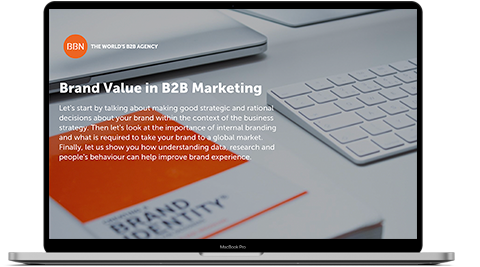Posted by BBN Central on 12th Apr 2024
The Brave New World of B2B Influencers
Welcome to the third instalment, focusing on smart investment strategies for fearless marketers aiming to win market share in the
READ MOREPosted by JoDee George - BBN USA (Milwaukee) on 7th Aug 2017
Business-to-business marketing is undergoing a much-needed makeover to better align to sales and business results. Old ways of thinking aren’t going to deliver the results needed. Whether your business now claims their territory as B2B, or B2B2C or B2P (people) or B2H (human), a shift in focus is warranted.
Customers, stakeholders, influencers decision-makers, and consumers — every stop on the supply chain requires renewed attention, and marketers are clamoring for ways to add value at each waypoint. Finding new thinking and new marketing strategies that move the needle is essential.
The solution is relatively simple: Put people – not product – at the center of everything you do.
And to be clear, people are your target audience.
People are whoever is an important audience that you spend time thinking about, developing content for and considering how to contact. People are who you need to persuade to buy whatever it is you’re selling.
This isn’t business as usual. It’s hard, messy and pretty scary. But as you consider next steps, there are two areas to focus on to begin adopting a people-focused approach.
Nearly seven people. That’s the number of people involved in any complex buying decision these days according to CEB. And when thousands of senior executives described the purchase process in one word, the words included “hard,” “awful,” “painful,” “frustrating” and “minefield.”
We at BBN USA are helping our clients ensure they receive more positive descriptors of the buying experience. To do that, you need to put yourself in your customer’s shoes. That’s easier said than done, but it starts with mapping.
The secret to great customer mapping is to make sure you’re not simply tracking your preferred journey as you see it, from your great product to your customer to their consumer. Don’t explore how you plot and plan for a customer to buy a product from you. Instead explore the goals your customers have – and even the goals their customers have.
Knowing the path to purchase your product isn’t enough anymore because the stakes for getting your target’s journey right have never been higher. In this age of disruption, if you aren’t crystal clear on the experience your customers need, they will take their business elsewhere.
“Storytelling” may be one of the most popular words in our marketing lexicon right now, but we often aren’t using it right. Few would deny that a brand telling a story is a good path to take, but our problem is, we tell our own story, not our target audience’s story
Human beings are too self-obsessed to care about someone else’s story most of the time. They don’t want to have to search for the meaning in your story and figure out how it benefits them. We can share endless lists of features and what we think are benefits, but if we haven’t inserted people, their beliefs, their behaviors, and their needs into the tale, we’re not making the connection. They simply don’t care.
The truth is, your target will care about their own story 100 percent of the time. Use the knowledge gained about your target and their desired experience to create conversations. It’s that simple: a conversation. Then develop the right content and use the right channel to reach them.
This simple shift is a pretty big change in almost every way. It is hard to step away from the comfort of what you know — your company, your products and your brands — and talk about someone else’s goals, bringing new insights to them.
How do you effect this change? Don’t start your presentation with “About Us”. Throw out your messages. And instead, have a conversation. These conversations, short and sweet that build over time, become clear and sequenced once we understand the experience the target is looking for. And under the conversations, we identify topics. Only then do we include what you might think of as messages today. And these messages tell your target’s story. Not what you want them to hear.
If you understand what type of experience your target wants, you can deliver it before someone else does. Then, tell your target’s story and connect by showing how you fit in that vision. Leading your organization down this path is how marketers can prove value in delivering sales and business results.
Want to know more about how marketers can prove value? Let’s talk.
Posted by JoDee George - BBN USA (Milwaukee) on 7th Aug 2017
We've gathered thoughts and expertise from our top strategists to bring you this insightful publication in B2B marketing. Get our e-Book to understand how you can build brand value in your organisation.

1 email a month, EXCLUSIVE stories, and 10 minutes of your time.
Subscribe now
Posted by BBN Central on 12th Apr 2024
Welcome to the third instalment, focusing on smart investment strategies for fearless marketers aiming to win market share in the
READ MORE
Posted by BBN Central on 5th Apr 2024
In B2B marketing, the compass that points businesses towards success is increasingly data-driven. Here at BBN, we've been keenly observing
READ MORE
Posted by BBN Central on 29th Mar 2024
Since the introduction of Sora, OpenAI's text-to-video model, the worlds of AI and marketing have been abuzz. It's being called
READ MORE
Posted by BBN Central on 19th Mar 2024
Account-Based Marketing (ABM) has rapidly gained traction in the B2B marketing world, promising personalized and efficient strategies to win over
READ MORE